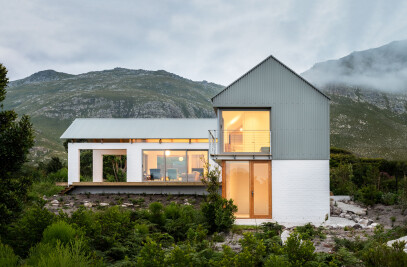The magnificent site of this substantial alteration was previously occupied by an uninspiring face brick and fibre cement laslappie house in typical South African beach house parlance.

The proximity of the ocean to the south and Kogelberg Biosphere Mountains to the north, together with the existing vegetation and climatic considerations provided the parameters that would ultimately arrange the new house, both in terms of spatial organisation and material expression.

The bedrooms on the western side of the site, together with some existing vegetation form one edge of a new courtyard, protected from the southeast wind by the existing garage and a new entrance walkway.

The living area preserves the footprint of the original house and retains the fireplace as focal point, albeit in altered form. A new floating roof kinks theatrically to accommodate the mountain views to the north.

On the south side, a new master suite follows the subtle geometry set up by existing milkwood trees with a swimming pool extending towards the sea. While from the beach the house appears as a low-slung insertion into the landscape, nestled into the lush shrubbery, without competing with the mountain backdrop.

Materials are chosen for their robustness in an uncompromising environment. Untreated western red cedar cladding ages well to compliment the new grey zinc roof. Pergolas, roof overhangs and timber shutters protect large glass panels from the sun and provide privacy, as required. Locally sourced stone walls further add to a natural palette, which attempts to make the passing of time and a sense of place a part of the construction.

The house offers its inhabitants the delights of understanding the seasons and the unique natural environment in an uncomplicated, but sophisticated manner with spaces that allow for a variety of experiences throughout the day.


















































